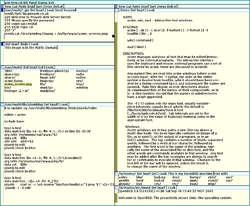| Acme | |
|---|---|
 A screenshot of Acme | |
| Original author(s) | Rob Pike |
| Operating system | Plan 9, Inferno, Unix-like, Windows |
| Type | Text editor |
| License | MIT [1] GPL-2.0-only [2] [3] LPL-1.02 [4] |
| Website | acme |
Acme is a text editor and graphical shell from the Plan 9 from Bell Labs operating system, designed and implemented by Rob Pike. It can use the Sam command language. The design of the interface was influenced by Oberon. It is different from other editing environments in that it acts as a 9P server. A distinctive element of the user interface is mouse chording.